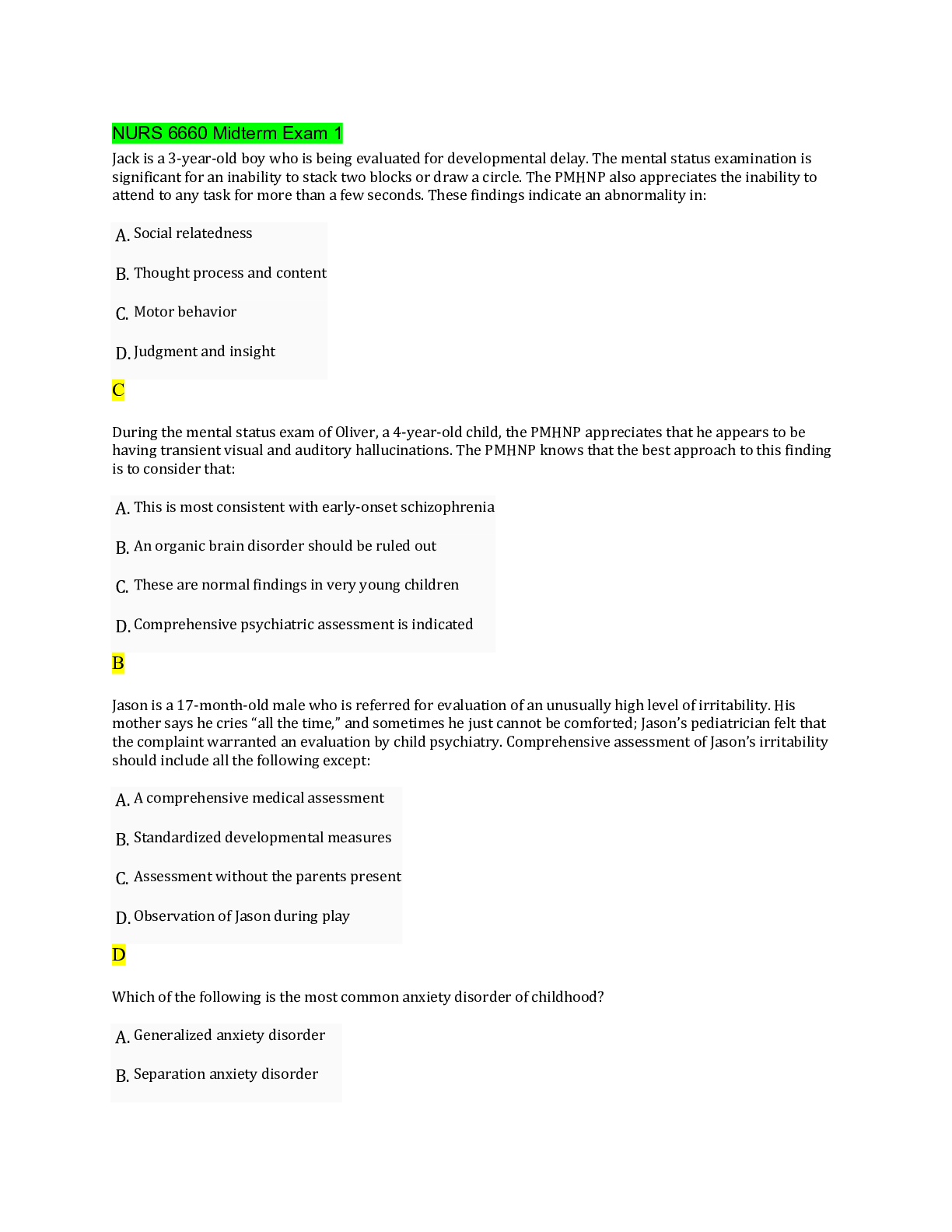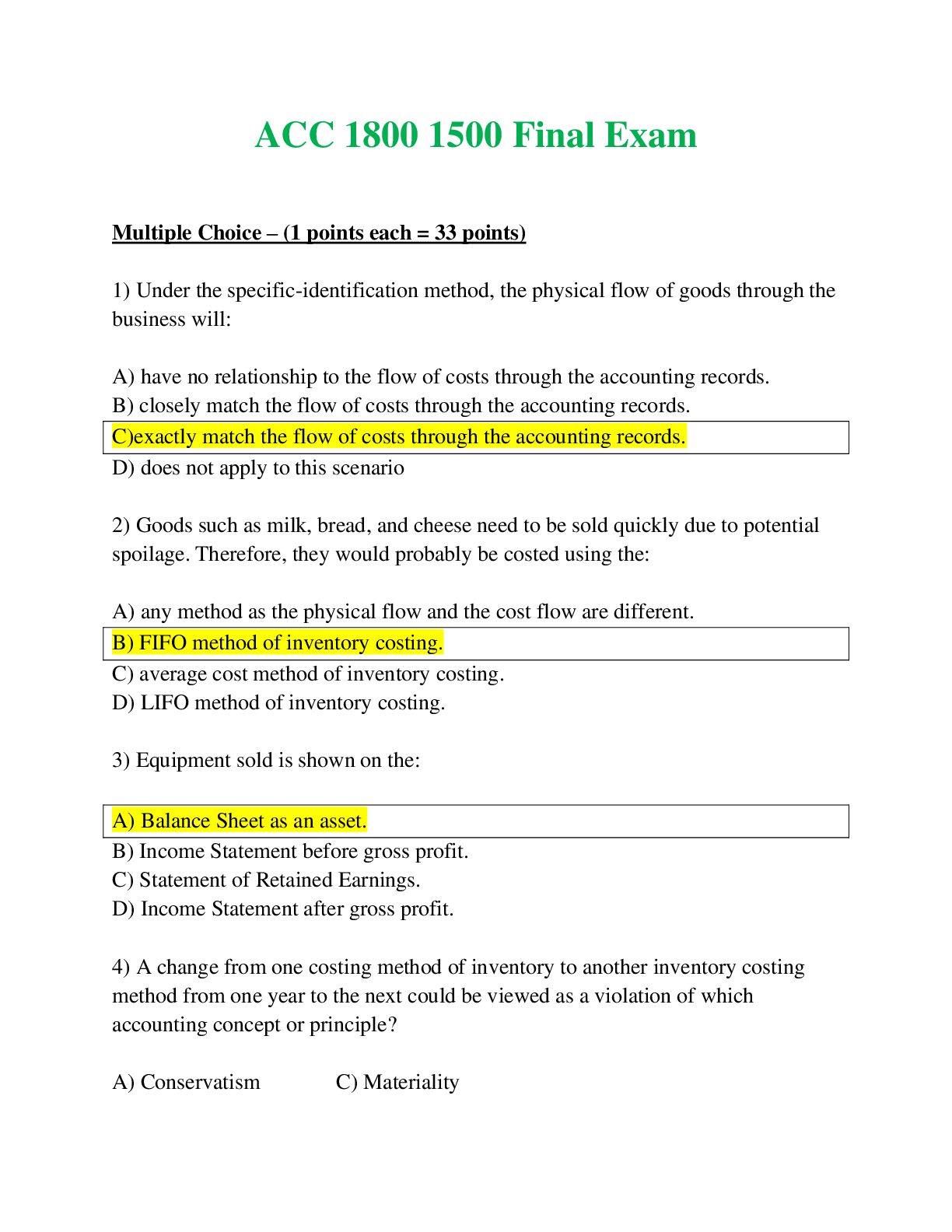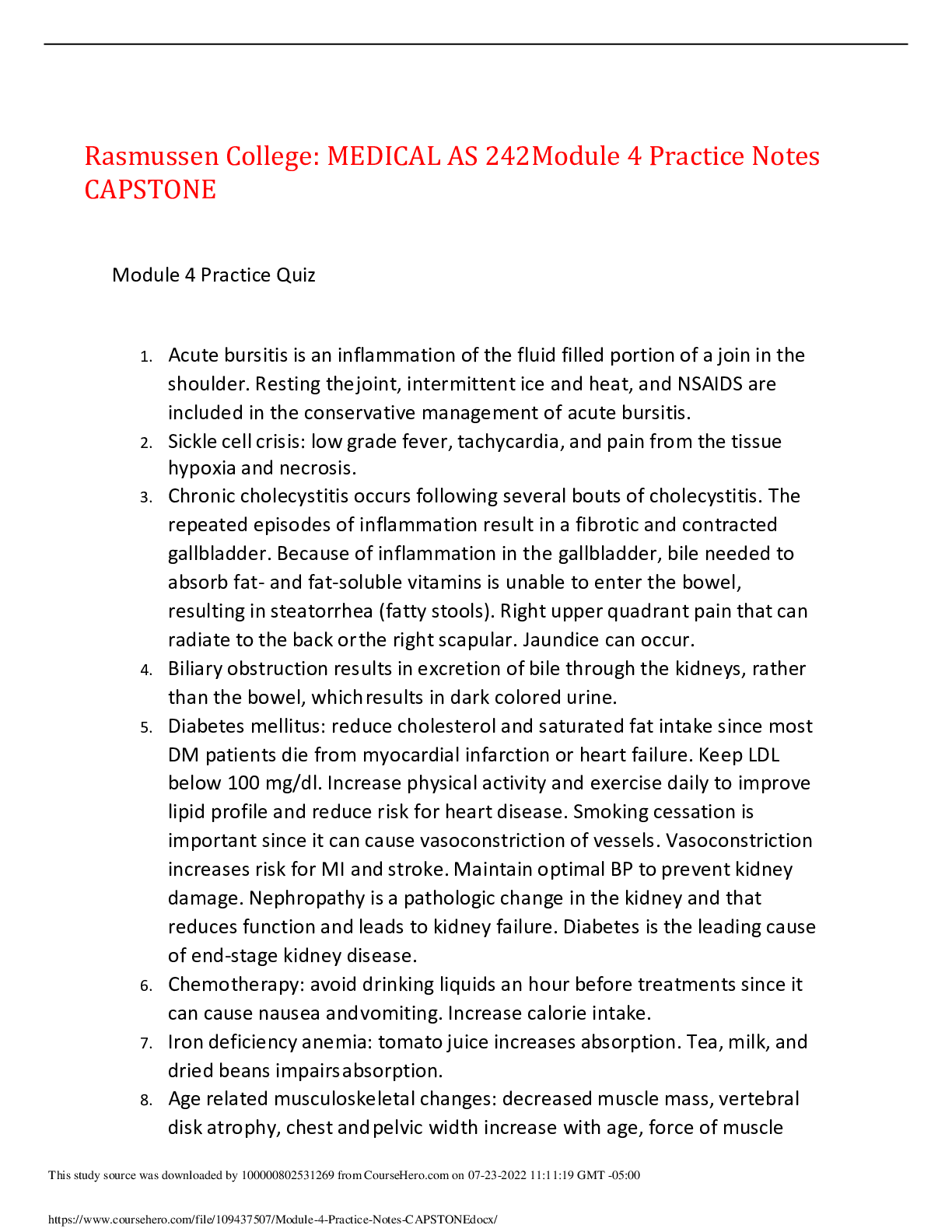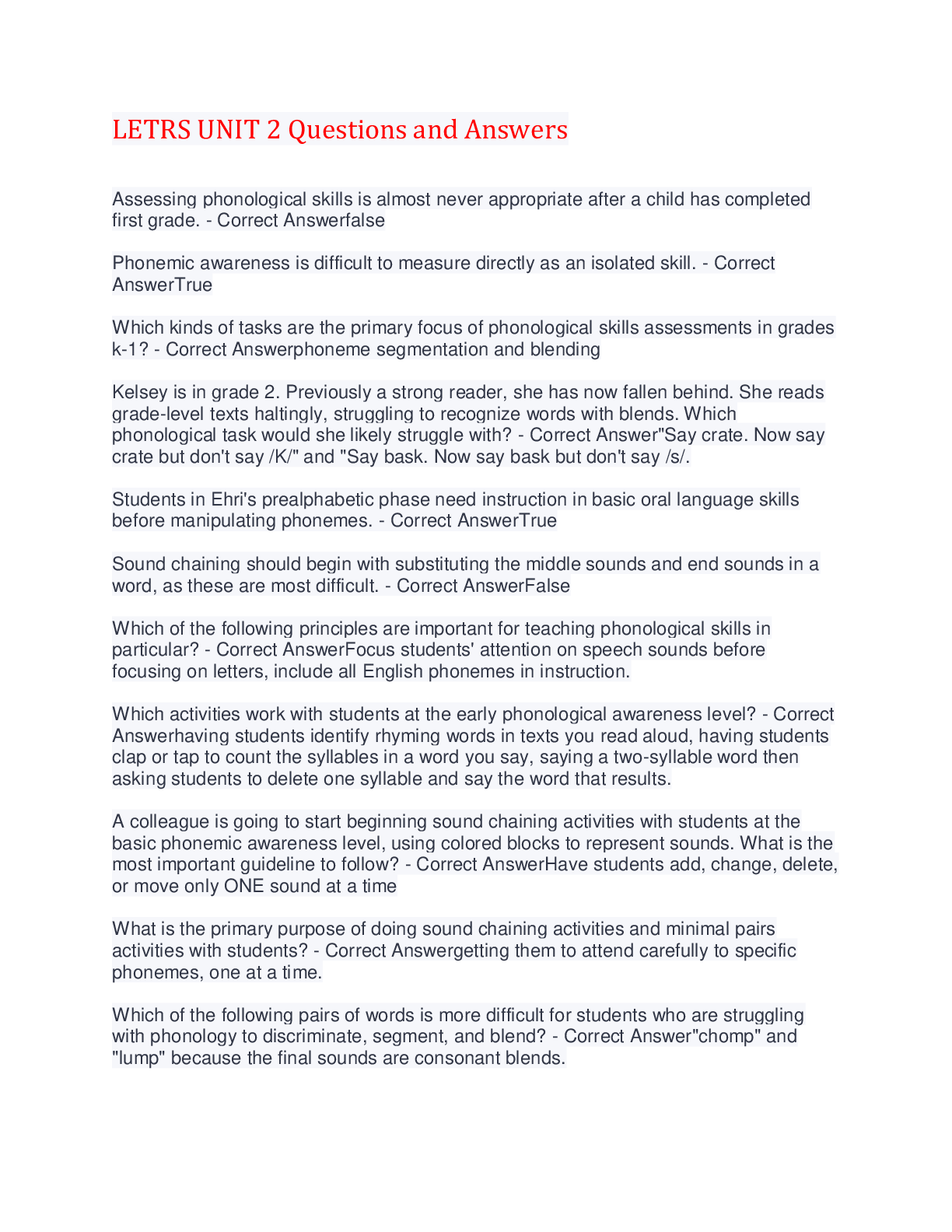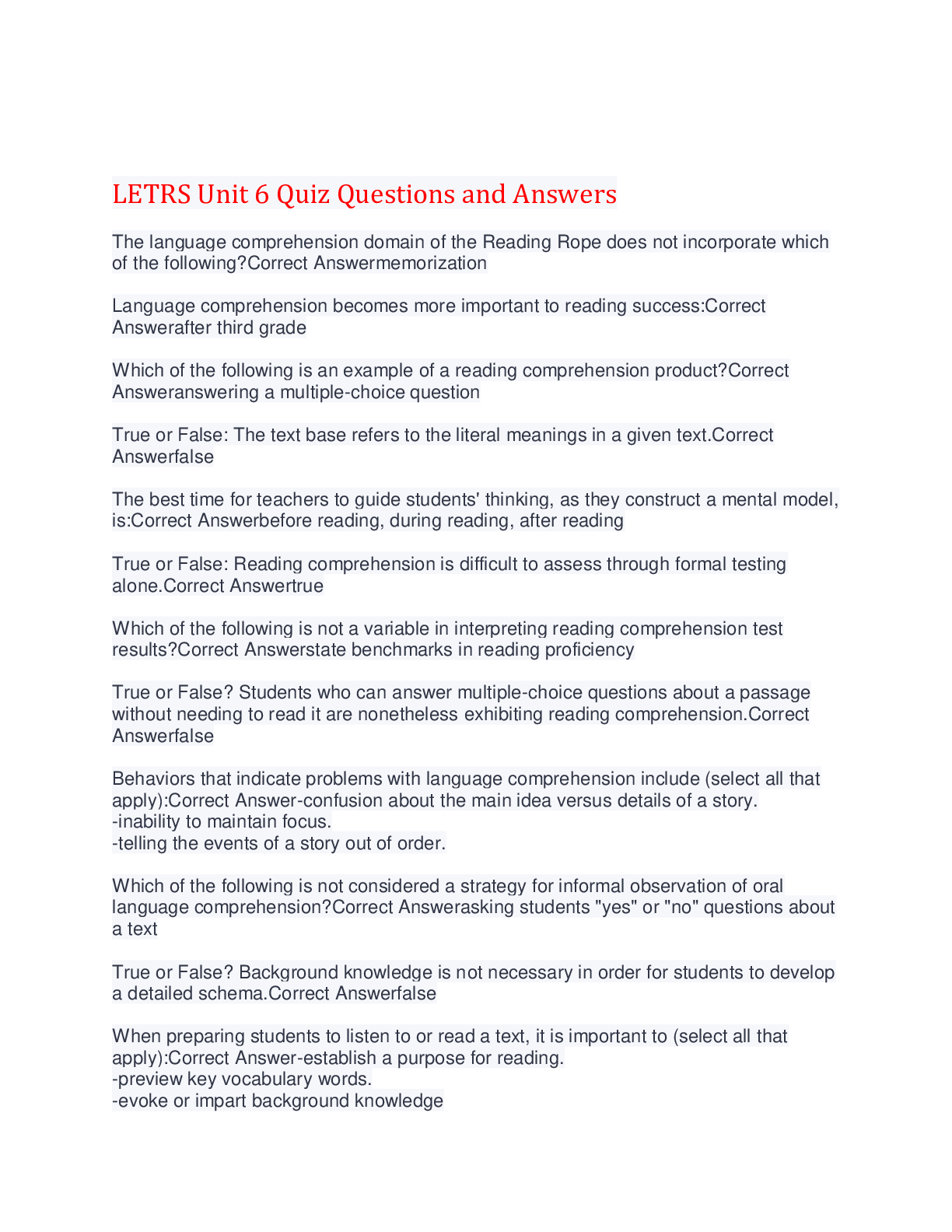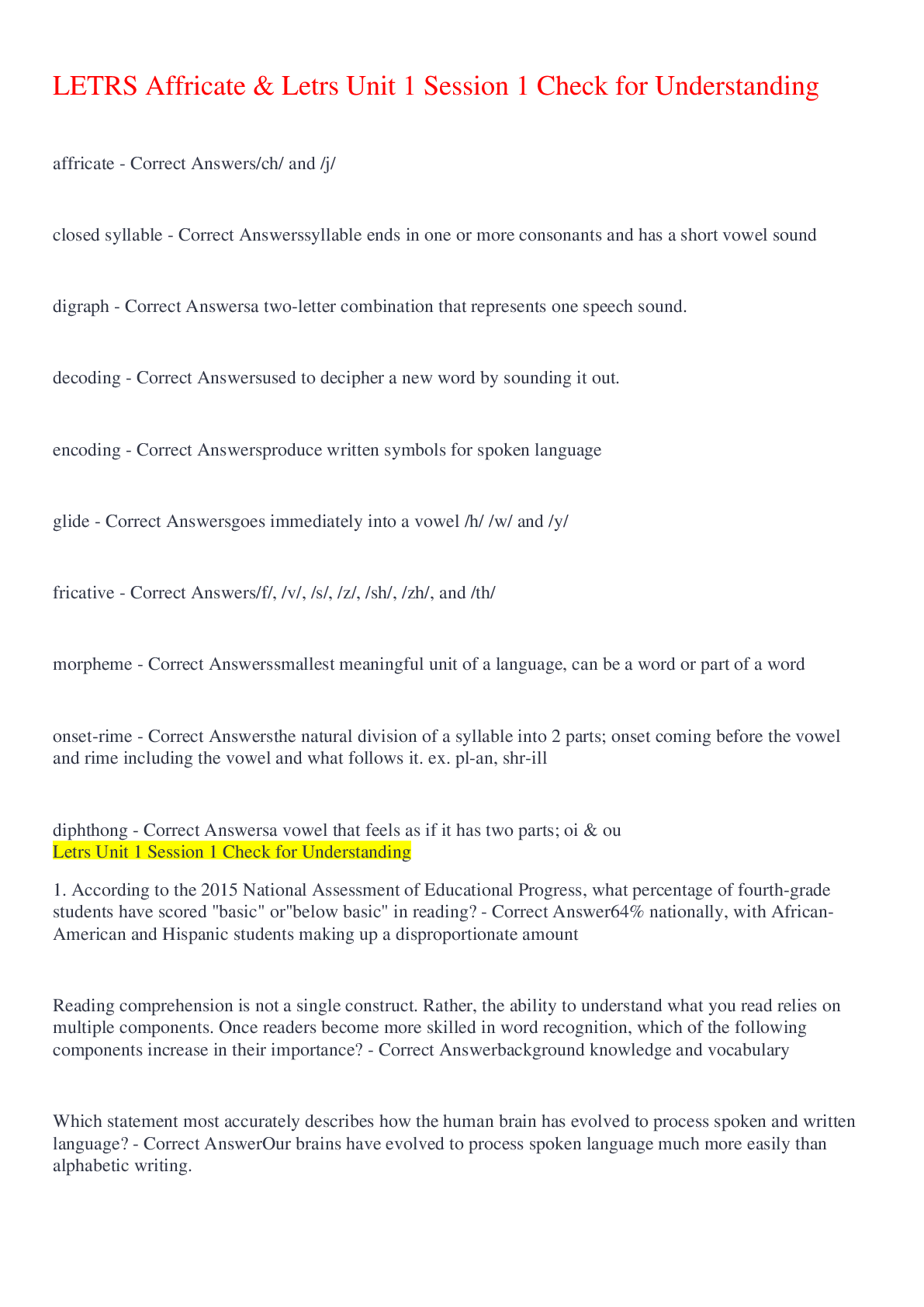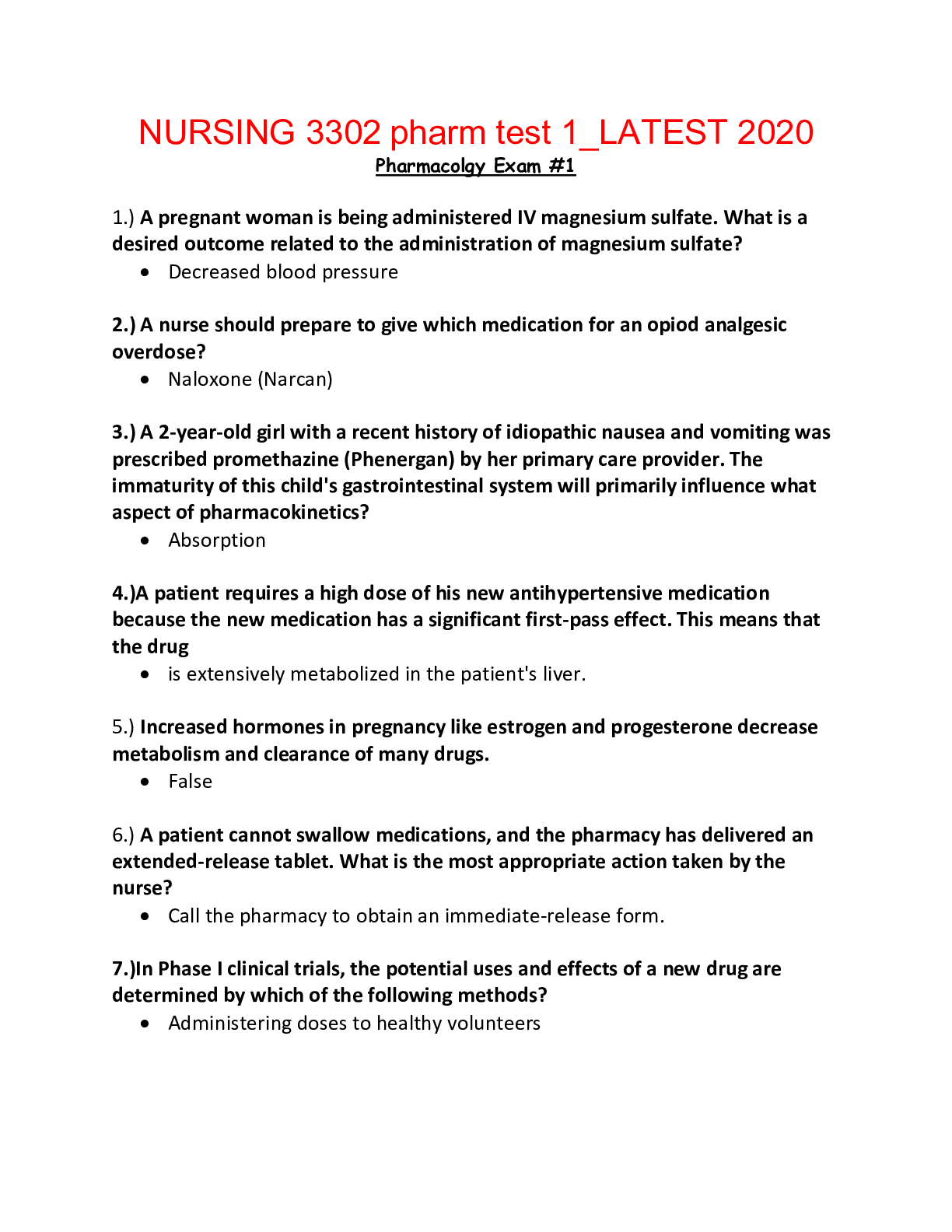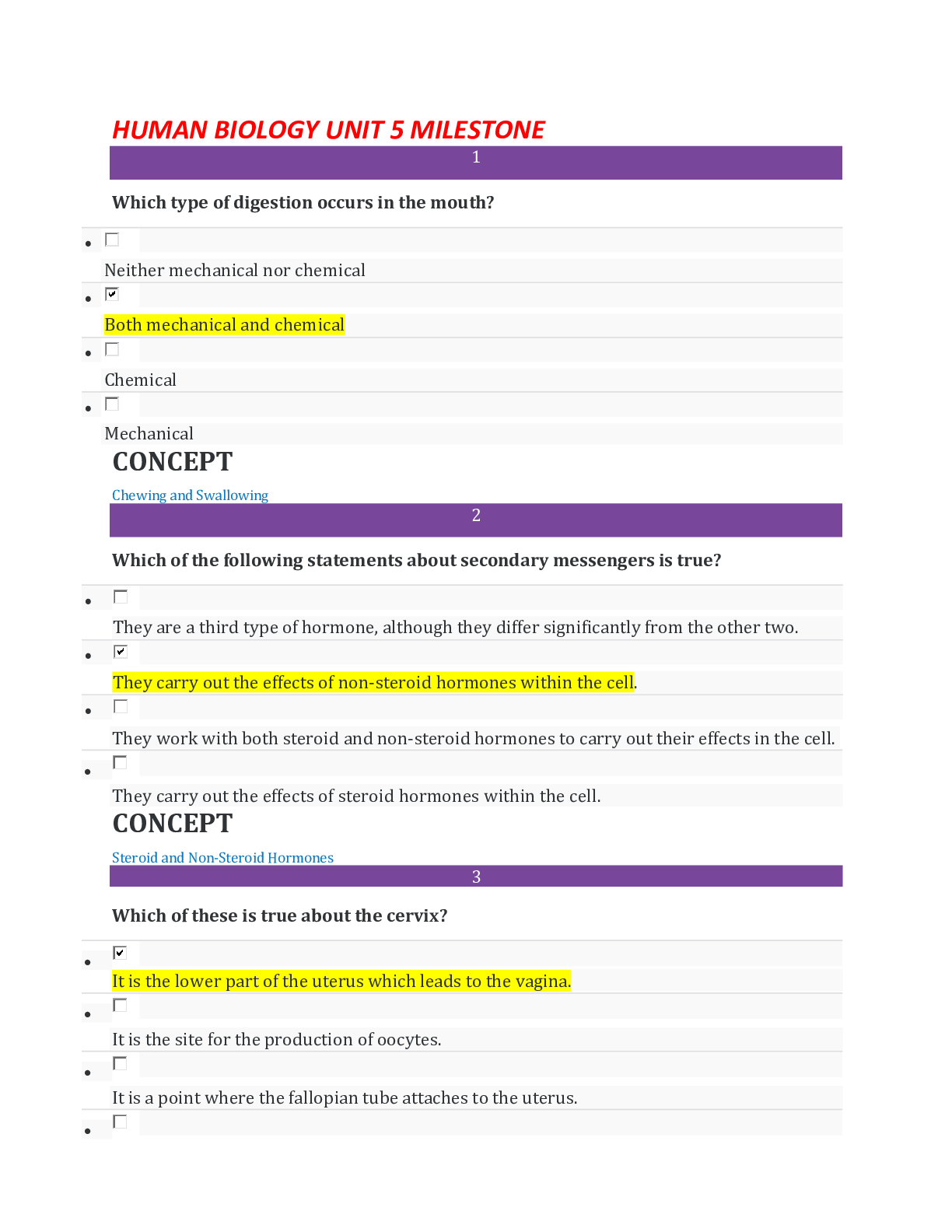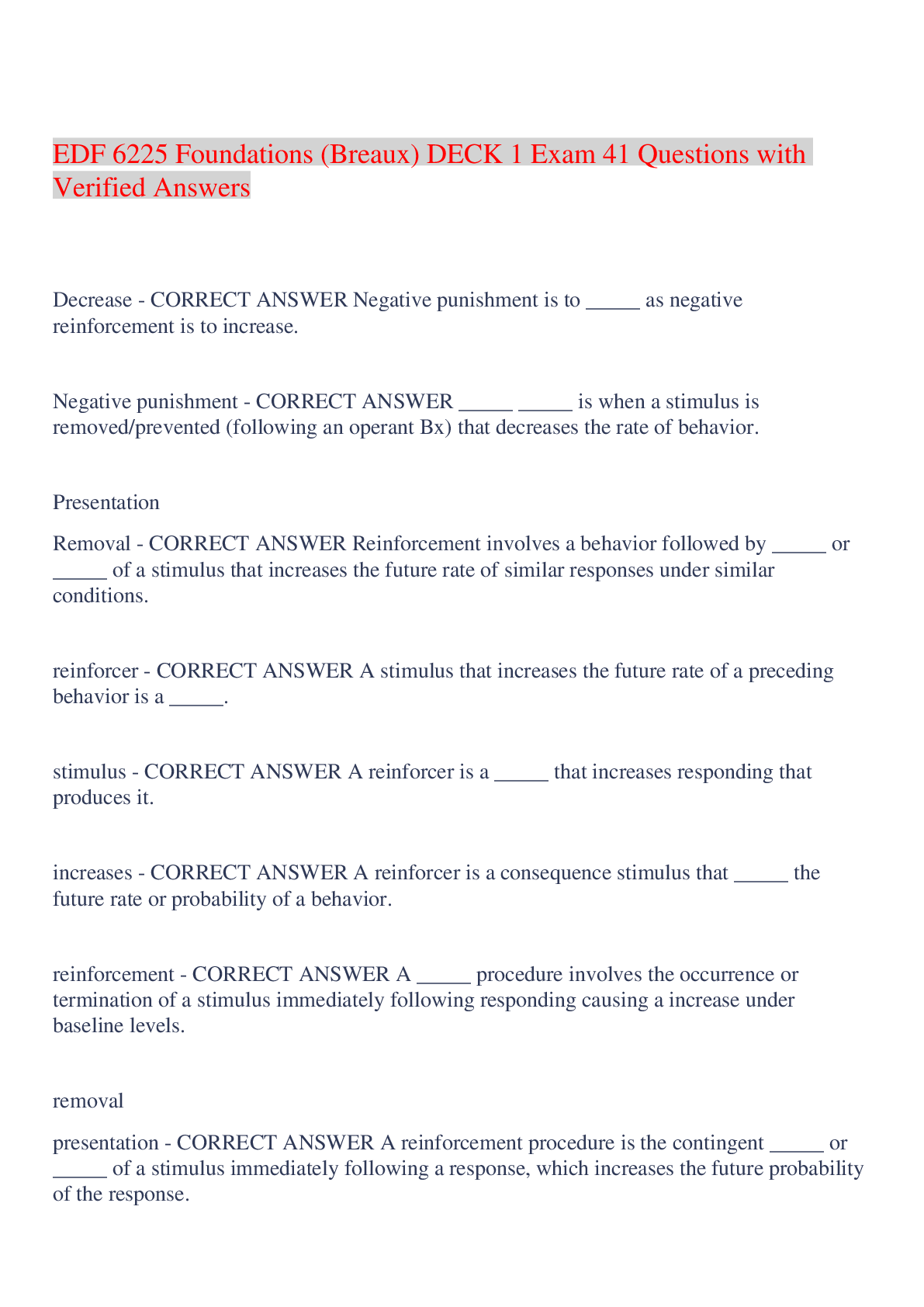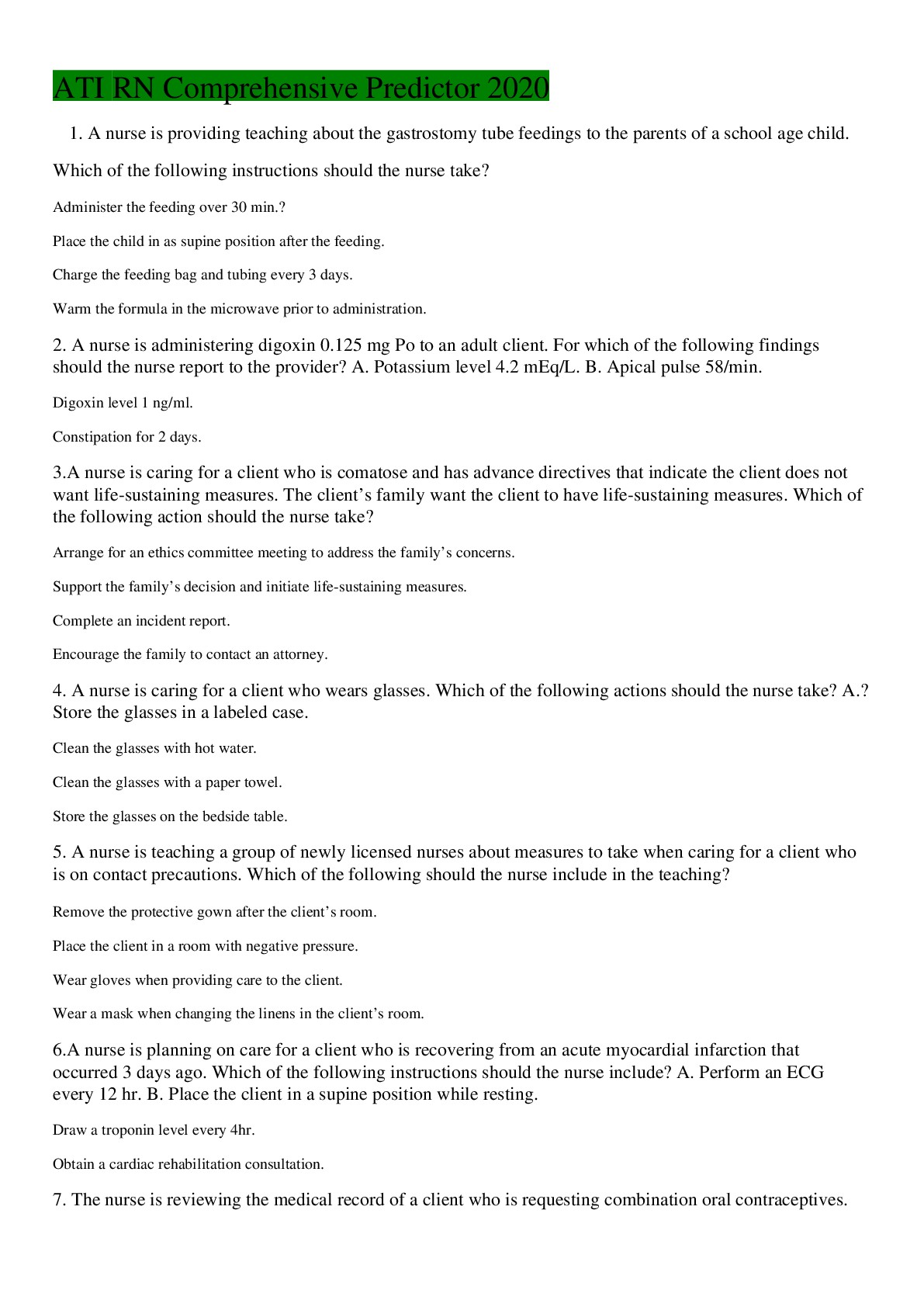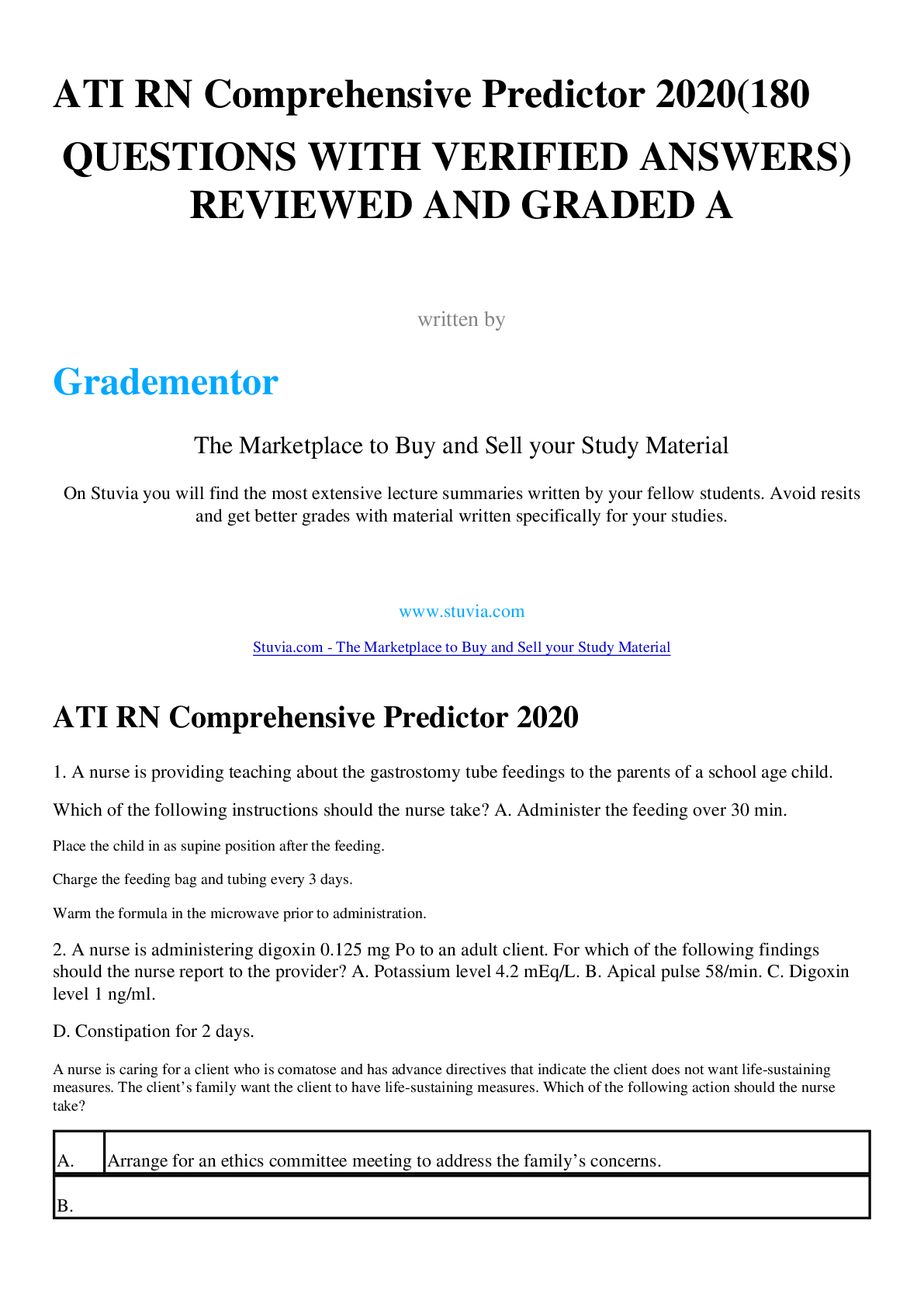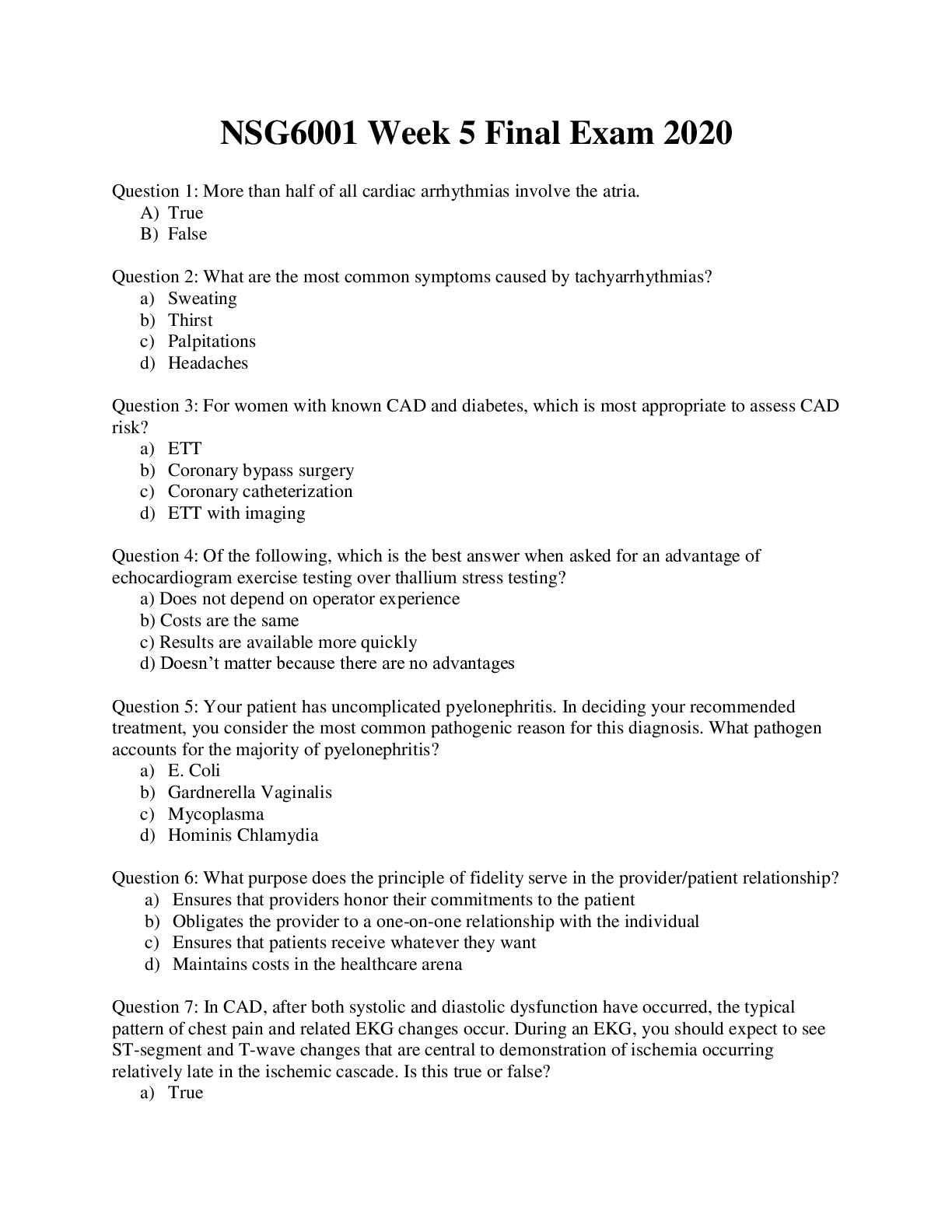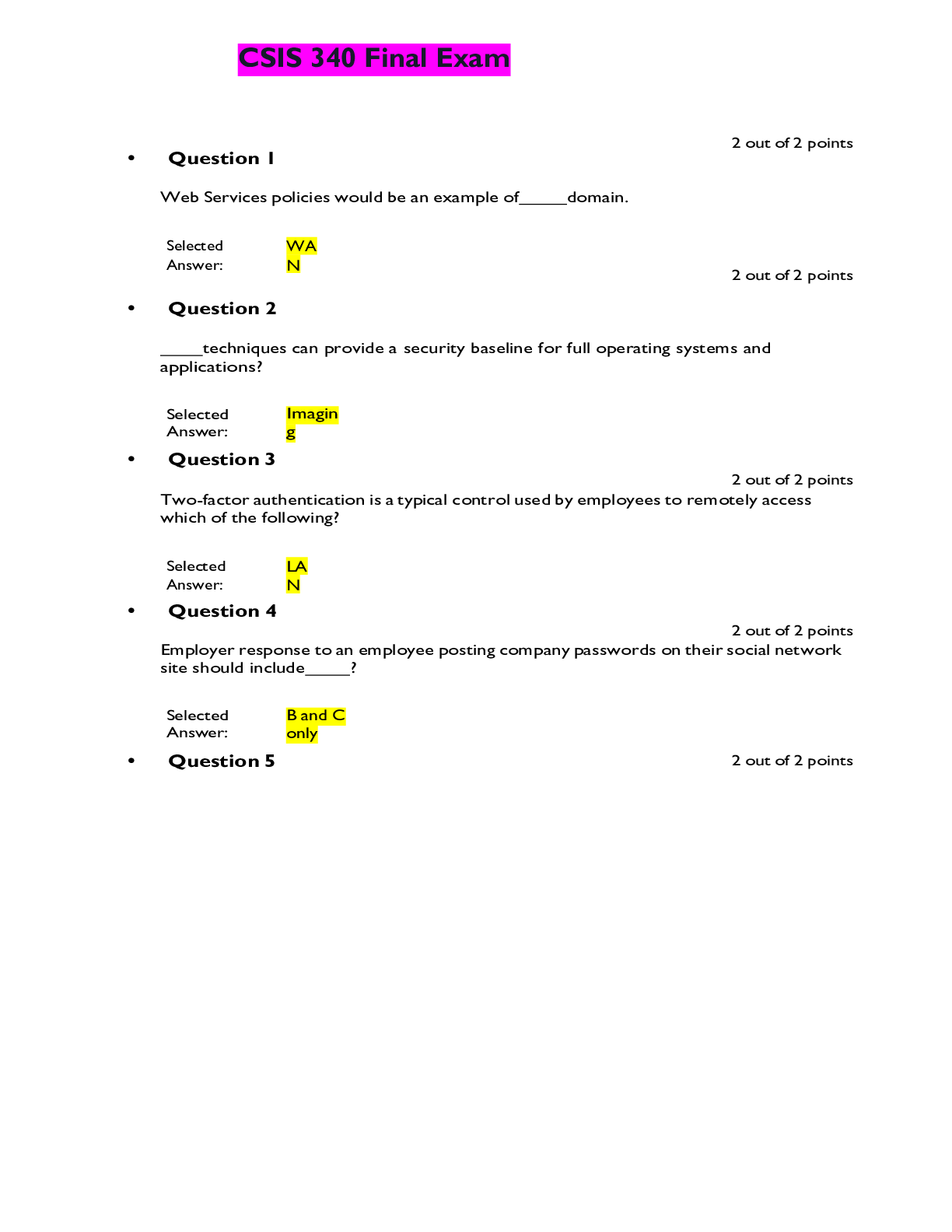CNRN Exam-2|50 Questions with Verified Answers,100% CORRECT
Document Content and Description Below
CNRN Exam-2|50 Questions with Verified Answers A patient who has had a stroke is being d/c home today. The patient's wife is concerned about caring for her husband at home. Which of the following i... s not an appropriate response to the patient's wife? A. Advise her to let him resume activity as tolerated B. Advise her to make a daily to-do list C. Advise bedrest except for bathing or toileting D. Advise to call 911 if there is any change in his behavior - CORRECT ANSWER C. Advise bedrest except for bathing or toileting Which of the following two medications should not be taken together? A. ASA and atorvastatin B. Ticagrelor and warfarin C. ASA and clopidogrel D. Esomeprazole and clopidogrel - CORRECT ANSWER D. Esomeprazole and clopidogrel Which of the following does not need to be avoided when taking warfarin? A. Kale B. Ginger C. Alcohol D. Iceberg lettuce - CORRECT ANSWER D. Iceberg lettuce A 1yo child with no significant past medical hx experiences a febrile seizure. Which of the following is not true statement regarding febrile seizures? A. A febrile seizure is a different than epilepsy B. Febrile seizures are relative common in young children C. Most febrile seizures are harmless D. Anticonvulsants are recommended to prevent future episodes - CORRECT ANSWER D. Anticonvulsants are recommended to prevent future episodes A patient is in the ICU for an intracerebral hemorrhage. Which of the following IV fluids is contraindicated in this patient? A. D5W B. LR C. NS D. Sodium Chloride 3% - CORRECT ANSWER A. D5W A patient remains in a persistent vegetative state following a high-speed car collision. CT scans have shown mild cerebral edema but no other abnormality. MRI of the brain reveals several punctuate hypodensities in addition to cerebral edema. What is the most likely diagnosis? A. SDH B. Diffuse axonal injury C. Multiple sclerosis D. SAH - CORRECT ANSWER B. Diffuse axonal injury Which of the following is consistent with Brown-Sequard syndrome? A. Loss of proprioception on the ipsilateral side of the injury B. Loss of temperature sensation on the ipsilateral side of the injury C. Loss of proprioception on the contralateral side as the injury D. Babinski sign contralateral to the side as the injury - CORRECT ANSWER A. Loss of proprioception on the ipsilateral side of the injury Which of the following is a rare etiology of spondylolisthesis? A. Isthmic B. Degernative disease C. Trauma D. Pathologic - CORRECT ANSWER C. Trauma Which of the following injuries is most likely to need a PEG tube? A. C2 B. C7 C. T2 D. T7 - CORRECT ANSWER A. C2 A patient has a tbi and a skull fracture following an assault. The nurse noted a halo sign on his sheets next to his right ear. Which bone did the patient most likely fracture? A. Frontal B. Temporal C. Parietal D. Occipital - CORRECT ANSWER B. Temporal Which of the following conditions increases the risk of CVA fourfold? A. Morbid obesity B. HTN C. Cocaine abuse D. A-fib - CORRECT ANSWER D. A-fib An incidental hemangioblastoma is found on imaging. What is the most appropriate intervention? A. Chemotherapy B. Radiation C. Serial imaging D. Surgical excision - CORRECT ANSWER C. Serial imaging Which of the following most likely metastasize to the brain? A. Renal cell carcinoma B. Lymphoma C. Colorectal cancer D. Pancreatic cancer - CORRECT ANSWER A. Renal cell carcinoma A patient involved in a diving accident has an injury to his spine. He has impaired function of his arms requiring assistance with oral feeds. He is paraplegic and can operate a motorized wheelchair. He is able to breathe on his own. He is incontinent and requires an indwelling catheter. Which of the following levels is most likely affected? A. C2 B. C7 C. T2 D. T7 - CORRECT ANSWER B. C7 Following the administration of a vaccine 1 week prior, an otherweise healthy child develops HA, N&V, confusion, and visual disturbances. After administration of steroids, the patient's condition gradually improves. What is the most likely diagnosis? A. Acute disseminating encephalomyelitis B. Chronic inflammatory demyelinating polyneuropathy C. Myasthenia gravis D. ALS - CORRECT ANSWER A. Acute disseminating encephalomyelitis A patient presents with a gradually worsening tremor that started in his right arm and traveled to his right leg. He remained conscious throughout the entire episode and was awake and alert following the episode. What type of seizure did he experience? A. Simple partial seizure B. Complex partial seizure C. Petit mal seizure D. Grand mal seizure - CORRECT ANSWER A. Simple partial seizure Which of the following is not true regarding posterior reversible encephalopahy syndrome? A. Malignant HTN may cause PRES B. If left untreated, it can cause hydrocephalus C. CT scan is the best diagnostic scan D. Seizures are the most common presenting symptom - CORRECT ANSWER C. CT scan is the best diagnostic scan A patient is trying to get pregnant and inquires how to help prevent her unborn child from developing spina bifida. What is the most appropriate response? A. having 1-2 glasses of red wine at night B. Eating a low sugar diet C. Drinking 3 glasses of milk per day D. Eating several oranges daily - CORRECT ANSWER D. Eating several oranges daily Which of the following statements regarding acute disseminated encephalomyelitis and multiple sclerosis are false? A. Steroids are used in teh medial care of both MS and ADEM B. ADEM primarily occurs in young adults C. ADEM is an inflammatory demyelinating condition D. MS is a chronic relapsing and remitting disease - CORRECT ANSWER B. ADEM primarily occurs in young adults An obese female with a known history of cocaine abuse is admitted for an acute ischemic stroke. The patient has a known history of sickle cell disease and htn. How man risk factors for stroke does this patient have? A. 2 B. 3 C. 4 D. 5 - CORRECT ANSWER C. 4 A 70yo African american man with a history of tobacco abuse and DM presents to the ER with a right facial droop. He is diagnosed with an acute lacunar infarction and admitted. During his workup he is found to have a blood pressure of 178/98. His hemoglobin A1c is 9.2. His low density lipoprotein is 165. How many non modifiable risk factors does this patient have? A. Two B. Three C. Five D. Six - CORRECT ANSWER B. Three Which test should be ordered for suspected cryptococcal meningitis? A. Western blot B. India ink C. Rapid plasma reagin D. Monospot test - CORRECT ANSWER B. India ink A patient with suspected meningitis has undergone a lumbar puncture. Which of the following CSF results are most consistent with a viral etiology? A. purulent csf, high WBC, elevated protein B. clear csf, high WBC elevated protein C clear csf, normal WBC, normal protein D. purulent CSF, high WBC, elevated protein - CORRECT ANSWER B. clear csf, high WBC, elevated protein When educating a patient about the warning signs of stroke, which of the following best describes the most common symptoms? A. loss of memory, ataxia, urinary incontinence B. hearing loss, facial weakness, ha C. facial droop, asymmetric weakness, dysarthria D. ataxia, resting tremor, muscle rigidity - CORRECT ANSWER C. facial droop asymmetric weakness, dysarthria A patient is placed on warfarin after an embolic stroke. The patient's PTINR is 1.5. The current dosage is 2 mg per day. What should the provider do regarding the dosage? A. increase the dosage to 4mg per day B. increase the dosage to 8mg per day C. maintain the same dosage D. decrease the dosage to 1mg per day - CORRECT ANSWER A. increase the dosage to 4mg per day Which one of these evaluations should be assessed first in a patient who recently had a stroke? A. skin assessment B. coping evaluation C. ability to void D. swallow evaluation - CORRECT ANSWER D. swallow evaluation A patient with an EVD has ICPs ranging from 25-30mmHg. There is no change in the neurological exam. Which of the following is the most appropriate intervention? A. No intervention, monitor patient B. raise the head of bed to 30 degrees C. flush the EVD D. Administer mannitol - CORRECT ANSWER B. raise the head of bed to 30 degrees A patient is being dc home with his family after being hospitalized for a stroke. Which of the following statements indicate the family needs further instruction? A. my family member's symptoms will resolve in a few months B. if my family member develops new symptoms i will call 911 C. i will assist as needed with activities of daily life D. i can expect that my family member and i may get frustrated - CORRECT ANSWER A. my family member's symptoms will resolve in a few months The following interventions are most likely to promote maximum self-care or a patient recovering from a tbi, except: A. allow the pt to ambulate without assistance to promote strength B. provide adaptive equipment as indicated C. educate patient on risks of repeat stroke D. encourage participation in activities of daily living - CORRECT ANSWER A. allow the pt to ambulate without assistance to promote strength A nurse enters a patient's room following a cardiac catheterization and notes that the patient is slurring. Which of the following actions should be done last? A. assess full vitals B. Do a full neurological assessment C. order a CT scan of the brain D. perform a dysphagia evaluation - CORRECT ANSWER D. perform a dysphagia evaluation Which of the following interventions is not appropriate for treating a patient with a chronic SDH? A. Physical therapy evaluation B. serial neurological exams C. give an anticonvulsant drug for prophylaxis D. Cognitive assessment - CORRECT ANSWER C. give an anticonvulsant drug for prophylaxis Which of the following is the most common tbi? A. SDH B. SAH C. concussion D. duffuse axonal injury - CORRECT ANSWER C. concussion A 33yo woman has a ha, slurred speech, coordination difficulties, and visual changes. She undergoes an MRi of the brain, which shows nonspecific white matter lesions consistent with plaque formation. Which of the following is the most appropriate treatment. A. antibiotics B. steroids C. antiplatelet therapy D. NSAIDS - CORRECT ANSWER B. steroids What is the primary nt affected in Parkinson disease? A. epi B. dopamine C. serotonin D. histamine - CORRECT ANSWER B. dopamine Which of the following best describes the etology for Creutzfeldt-Jakob disease? A. Prions B. Autoimmune C. Bacteria D. Unknown - CORRECT ANSWER A. Prions Which of the following diseases would find lewy bodies on brain biopsy? A. parkinson disease B. myasthenia gravis C. multiple sclerosis D. Craniopharyngioma - CORRECT ANSWER A. parkinson disease A patient is brought to the er for ams. She has a bag of medications with her, but cannot recall her medical issues. One of the pill bottles is carbidopa-levodpa. Which medical condition does she have? A. Creutzfeldt-Jakob disease B. Myasthenia gravis C. Multiple sclerosis D. Parkinson disease - CORRECT ANSWER D. Parkinson disease A patient's wife has just been told that her husband, who has been on hospice care for stage IV glioma, just died. She originally denied that he could be dead. She then became angry and started to blame his medical providers. Which of the following is not an appropriate action? A. calling the police B. calling a social worker C. calling a grief counselor D. calling a psychiatrist - CORRECT ANSWER A. calling the police A 29yo man had a new onset seizure after being involved in an assault. He is postictal, but is able to protect his own airway. Which of the following medications is the best initial medications to administer? A. Ethosuximide B. Phenytoin C. Levetriacetam D. Pentobarbital - CORRECT ANSWER B. Phenytoin Which of the following is true regarding craniopharyngiomas? A. they occur in the brain stem B. they are benign tumors C. they primarily occur in children D. There are no known risk factors - CORRECT ANSWER A. they occur in the brain stem A woman whose husband has been diagnosed with Huntington disease inquires how the disease is acquired. Which of the following responses is correct? A. autosomal recessive B. idiopathic C. autosomal dominant D. x-linked recessive - CORRECT ANSWER C. autosomal dominant A pt presents with progressively worsening personality changes and emotional issues. On physical exam the patient has a left facial droop and lef sided weakness. An mri of the rain reveals a glioma. Where is the most likely location of the mass? A. left frontal cortex B. left temporal cortex C. right frontal cortex D. right temproal cortex - CORRECT ANSWER C. right frontal cortex A patient is admitted with progressive neurological chagnes and blindness. A lumbar puncture is perfromed and the culture reveals Treponema pallidum. Which of the following si the most appropriate treatment? A. Penicillin B. Acyclovir C. Amphotericin B D. Sulfamethoxazole/Trimethoprim - CORRECT ANSWER A. Penicillin A pt has suspected aneurysmal SAH, but the CT scan of the brain is negative. What is another test that can confirm the diagnosis? A. skull series B. transcranial doppler C. mri of the brain D. lumbar puncture - CORRECT ANSWER D. lumbar puncture A pt in the ICU is admitted for a ruptured cerebral aneurysm. Which medication should be ordered to help prevent vasospasm? A. Metoprolol B. Nimodipine C. Carvedilol D. Candesartan - CORRECT ANSWER B. Nimodipine A 16yo female patient comes to the clinic with progressively worsening pedunculated masses over her entire body. She states that they are itching and painfu. Several relatives have similar signs and symptoms. Which of the follwoing is the most likey diagnosis? A. ependymoma B. Hemangioblastoma C. Neurofibroma D. astrocytoma - CORRECT ANSWER C. Neurofibroma Which of the following is not true about Bell palsy? A. steroids are the maintstay of treatment B. permanent neurological deficits may occur C. Bell palsy signals a likely future stroke D. The etiology is unknown - CORRECT ANSWER C. Bell palsy signals a likely future stroke A neonate is diagnosed with herpes encephalitis. What is the most likely cause? A. nosocmial infection B. the infant is immunocompromised C. latrogenic cause D. maternal transmission - CORRECT ANSWER D. maternal transmission A neonate is admitted to the hospital for status epilepticus. After the patient is stabilized,, imaging of the brain reveals SDH, retinal bleeding, and cerebral edema. What is the most likely diagnosis? A. encephalitis B. shaken baby syndrome C. meningitis D. acute disseminating encephalomyelitis - CORRECT ANSWER B. shaken baby syndrome A pt is admitted for possible seizure. Her symptoms do not correspond with findings on EEG. Which lab should be ordered to help differentiate between seizure and pseudoseizure? A. Prolactin B. Vitamin D C. Sodium D. Erthrocyte sedimentation rate - CORRECT ANSWER A. Prolactin [Show More]
Last updated: 1 year ago
Preview 1 out of 12 pages
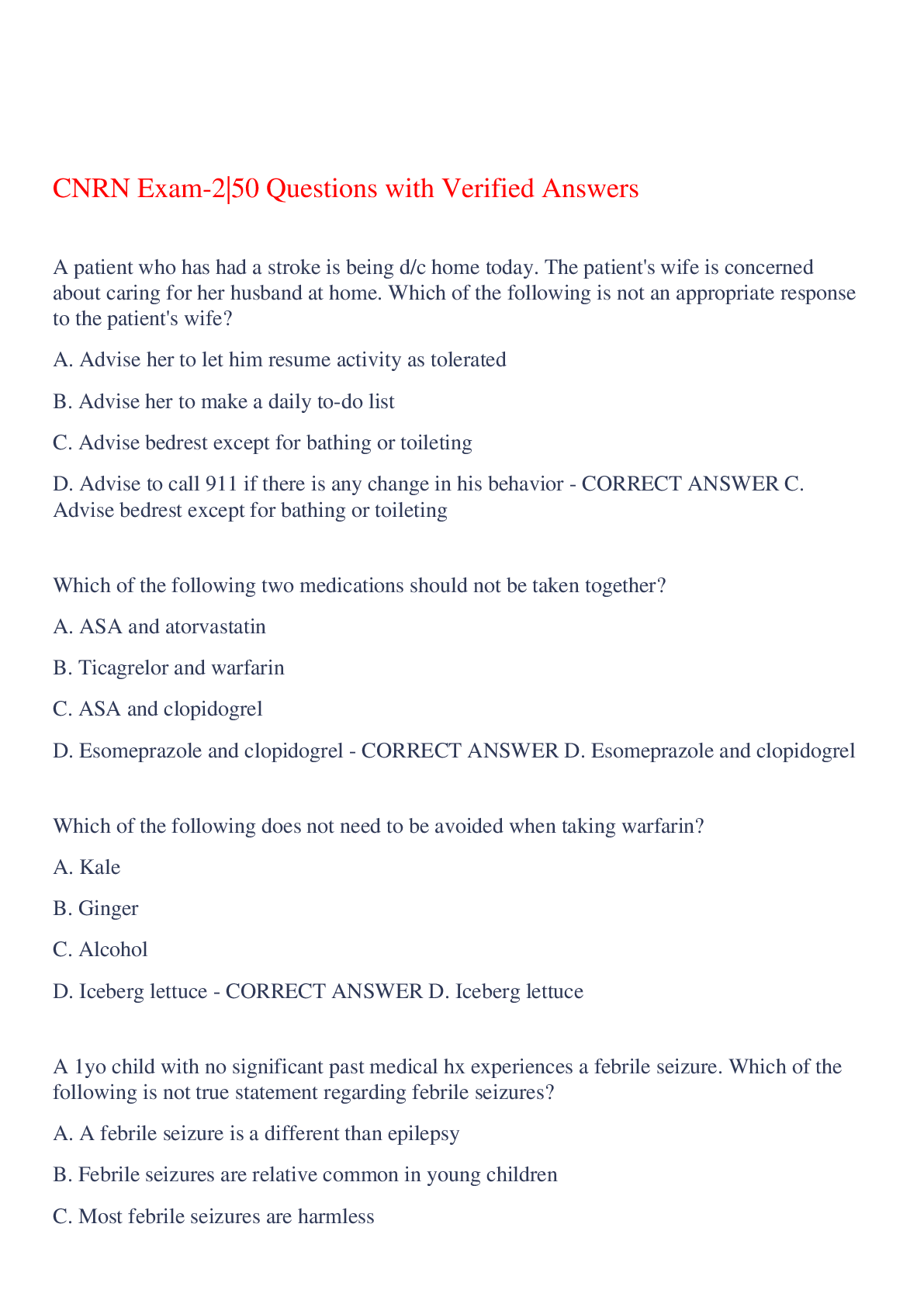
Buy this document to get the full access instantly
Instant Download Access after purchase
Buy NowInstant download
We Accept:

Reviews( 0 )
$8.50
Can't find what you want? Try our AI powered Search
Document information
Connected school, study & course
About the document
Uploaded On
Oct 24, 2023
Number of pages
12
Written in
Additional information
This document has been written for:
Uploaded
Oct 24, 2023
Downloads
0
Views
74



